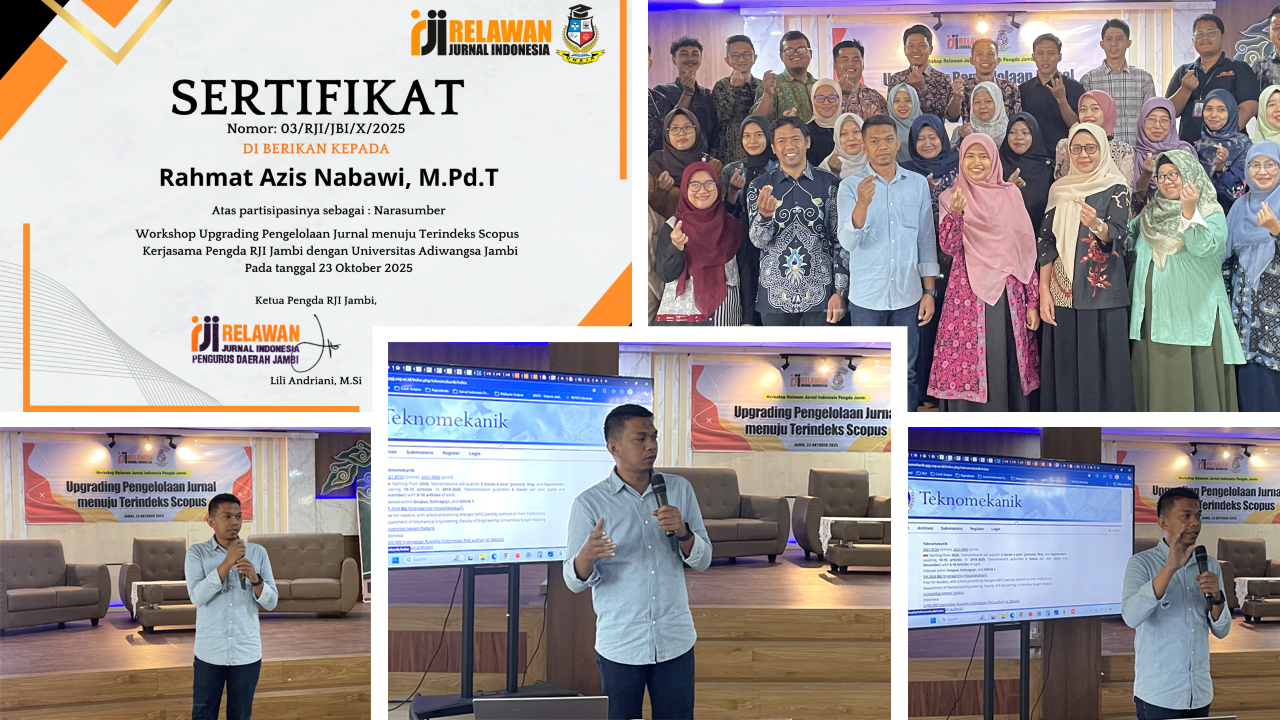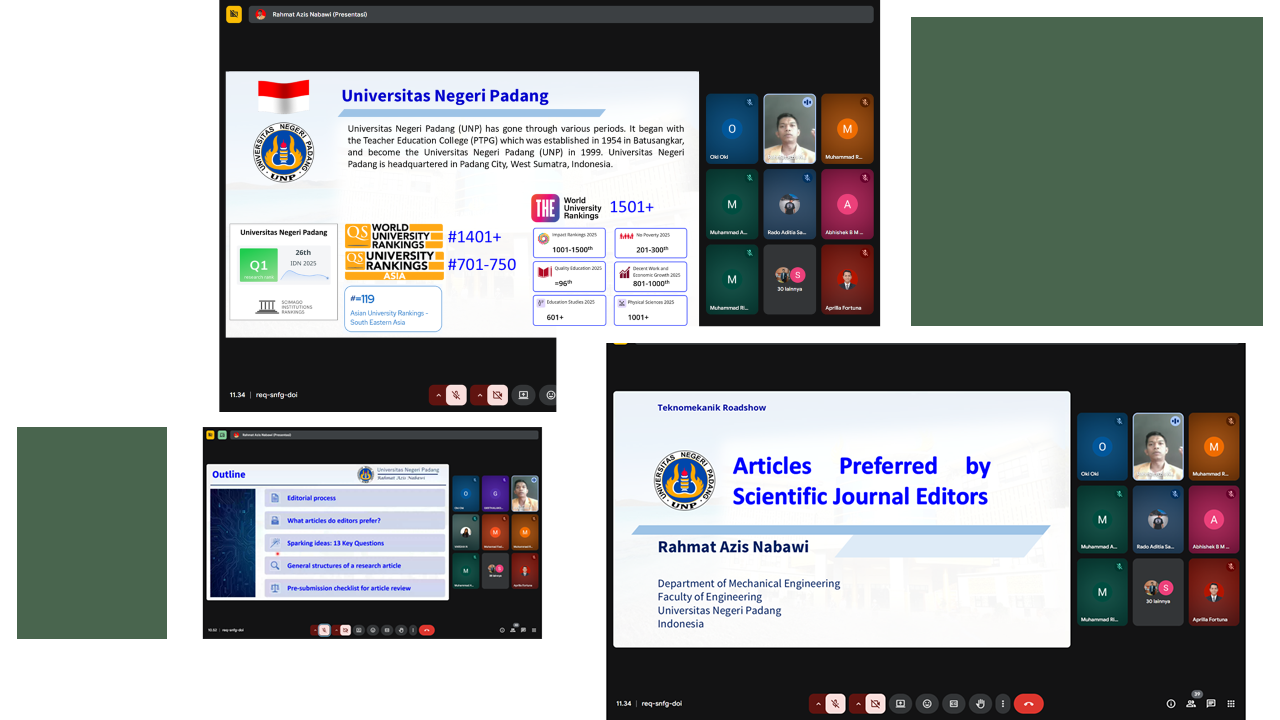Effect of sonication to the stability properties of carboxymethyl cellulose/uncaria gambir extract water-based lubricant
DOI:
https://doi.org/10.24036/teknomekanik.v5i2.16972Keywords:
Carboxymethyl cellulose, Uncaria gambir, Biodegradable lubricant, FTIR, Water based lubricantAbstract
This study examined the effect of sonication on FTIR and stability at various temperatures in water-based lubricants with a mixture of Carboxymethyl Cellulose (1wt%) and Uncaria Gambir extract (1wt% and 2wt%). The sample was prepared by mixing the two materials into distilled water using a magnetic stirrer and sonicator with time variations of 5 and 10 minutes. Before mixing, the Uncaria Gambir extract solution with water is first centrifuged to remove the dregs in the Uncaria Gambir extract powder. Stability was carried out in an open room (28oC), drying oven (50oC), and refrigerator (5oC). The stability test results showed that the mixture of Carboxymethyl Cellulose and Uncaria Gambir had good stability at all temperatures after sonication for a short duration. The longer sonication duration could fuse the fibrils of Carboxymethyl Cellulose, leading to increasing particle size. FTIR results also show that there is no chemical reaction that occurs. After adding the gambier, there was a new peak at wave 800-1300 cm-1, corresponding to the gambier. The results of this study indicate that the Carboxymethyl Cellulose and Uncaria Gambir solution can be a potential lubricant additive. The Carboxymethyl Cellulose can be a viscosity modifier, while Uncaria Gambir extract for corrosion inhibitor.
Downloads
References
C. D. Rakhmania, S. R. Sari, Y. I. Azhar, A. Sugita, and M. Tominaga, “Cellulose Nanofiber Platform for Electrochemical Sensor Device: Impedance Measurement Characterization and Its Application for Ethanol Gas Sensor,” Teknomekanik, vol. 5, no. 1, pp. 57–62, 2022. https://doi.org/10.24036/teknomekanik.v5i1.12872
M. M. Hussain, A. P. Pratap, and V. R. Gaval, “Study of vegetable oil based biolubricants and its hydrodynamic journal bearing application: A review,” Tribol. Ind., vol. 43, no. 4, pp. 511–523, 2021. https://doi.org/10.24874/ti.979.10.20.02
D. Rahmadiawan, H. Abral, N. Nasruddin, and Z. Fuadi, “Stability , Viscosity , and Tribology Properties of Polyol Ester Oil-Based Biolubricant Filled with TEMPO-Oxidized Bacterial Cellulose Nanofiber,” Int. J. Polym. Sci., vol. 2021, no. Natural Fiber-Reinforced Biopolymer Composites, 2021. https://doi.org/10.1155/2021/5536047
M. A. Hossain, M. A. Mohamed Iqbal, N. M. Julkapli, P. San Kong, J. J. Ching, and H. V. Lee, “Development of catalyst complexes for upgrading biomass into ester-based biolubricants for automotive applications: A review,” RSC Adv., vol. 8, no. 10, pp. 5559–5577, 2018. https://doi.org/10.1039/C7RA11824D
M. A. N. Barsari and A. Shirneshan, “An Experimental Study of Friction and Wear Characteristics of Sunflower and Soybean Oil Methyl Ester under the Steady-State Conditions by the Four-Ball Wear Testing Machine,” J. Tribol., vol. 141, no. 4, 2019. https://doi.org/10.1115/1.4042390
B. Zakani, S. Entezami, D. Grecov, H. Salem, and A. Sedaghat, “Effect of ultrasonication on lubrication performance of cellulose nano-crystalline (CNC) suspensions as green lubricants,” Carbohydr. Polym., vol. 282, no. May 2021, p. 119084, 2022. https://doi.org/10.1016/j.carbpol.2021.119084
N. F. Azman, S. Samion, M. A. A. Moen, M. K. Abdul Hamid, and M. N. Musa, “The anti-wear and extreme pressure performance of CuO and graphite nanoparticles as an additive in palm oil,” Int. J. Struct. Integr., vol. 10, no. 5, pp. 714–725, 2019. https://doi.org/10.1108/IJSI-03-2019-0026
D. Rahmadiawan, N. Aslfattahi, N. Nasruddin, R. Saidur, A. Arifutzzaman, and H. A. Mohammed, “MXene Based Palm Oil Methyl Ester as an Effective Heat Transfer Fluid,” J. Nano Res., vol. 68, pp. 17–34, 2021. https://doi.org/10.4028/www.scientific.net/jnanor.68.17
Z. Fuadi, D. Rahmadiawan, R. Kurniawan, F. Mulana, and H. Abral, “Effect of Graphene Nanoplatelets on Tribological Properties of Bacterial Cellulose / Polyolester Oil,” vol. 8, no. March, pp. 1–11, 2022, https://doi.org/10.3389/fmech.2022.810847
D. Rahmadiawan, N. Nasruddin, P. Primawati, S. R. Primandari, P. Purwantono, and R. A. Nabawi, “Life Cycle Assessment of Synthetic Polyolester Oil-Based Biolubricant Filled with Bacterial Cellulose Nanofiber,” Int. J. Life Cycle Assess., pp. 1–6, 2022.
D. Rahmadiawan, Z. Fuadi, R. Kurniawan, H. Abral, F. Ilhamsyah, and A. Arafat, “Tribological Properties of Aqueous Carboxymethyl Cellulose / Uncaria Gambir Extract as Novel Anti-Corrosion Water-Based Lubricant,” Tribol. Ind., 2022. https://doi.org/10.24874/ti.1357.08.22.10
N. Erizon, J. Jasman, S. Syahrul, and W. Wakhinuddin, “Manufacture of Gambir Leaf Press Impac System in Efforts to Increase Productivity of Gambir Farmers,” Teknomekanik, vol. 2, no. 2, pp. 68–75, 2019. https://doi.org/10.24036/tm.v2i1.3972
J. Jasman, N. Erizon, I. Irzal, and J. Ardi, “Making Print Tool Gambir Sap Parallel Slinder System,” Teknomekanik, vol. 2, no. 2, pp. 61–67, 2019, https://doi.org/10.24036/tm.v2i1.3872.
H. Abral et al., “Anti-UV, antibacterial, strong, and high thermal resistant polyvinyl alcohol/Uncaria gambir extract biocomposite film,” J. Mater. Res. Technol., vol. 17, pp. 2193–2202, 2022. https://doi.org/10.1016/j.jmrt.2022.01.120
H. Abral, A. Kurniawan, D. Rahmadiawan, D. Handayani, E. Sugiarti, and A. N. Muslimin, “Highly antimicrobial and strong cellulose-based biocomposite film prepared with bacterial cellulose powders, Uncaria gambir, and ultrasonication treatment,” Int. J. Biol. Macromol., vol. 208, no. March, pp. 88–96, 2022. https://doi.org/10.1016/j.ijbiomac.2022.02.154
M. S. Kumar, V. Vasu, and A. V. Gopal, “Thermal conductivity and rheological studies for Cu–Zn hybrid nanofluids with various basefluids,” J. Taiwan Inst. Chem. Eng., vol. 66, pp. 321–327, 2016. https://doi.org/10.1016/j.jtice.2016.05.033
Hiemenz, P. C. and R. Rajagopalan, Principles of Colloid and Surface Chemistry, revised and expanded. CRC press, 2016.
L. Samylingam et al., “Thermal analysis of cellulose nanocrystal-ethylene glycol nanofluid coolant,” Int. J. Heat Mass Transf., vol. 127, pp. 173–181, 2018. https://doi.org/10.1016/j.ijheatmasstransfer.2018.07.080
D. Rahmadiawan et al., “The Enhanced Moisture Absorption and Tensile Strength of PVA/Uncaria gambir Extract by Boric Acid as a Highly Moisture-Resistant, Anti-UV, and Strong Film for Food Packaging Applications,” J. Compos. Sci., vol. 6, no. 11, p. 337, 2022. https://doi.org/10.3390/jcs6110337
P. Paximada, E. A. Dimitrakopoulou, E. Tsouko, A. A. Koutinas, C. Fasseas, and I. G. Mandala, “Structural modification of bacterial cellulose fibrils under ultrasonic irradiation,” Carbohydr. Polym., vol. 150, pp. 5–12, 2016. https://doi.org/10.1016/j.carbpol.2016.04.125
H. Abral, V. Lawrensius, D. Handayani, and E. Sugiarti, “Preparation of nano-sized particles from bacterial cellulose using ultrasonication and their characterization,” Carbohydr. Polym., vol. 191, pp. 161–167, 2018. https://doi.org/10.1016/j.carbpol.2018.03.026
M. Asrofi, H. Abral, A. Kasim, A. Pratoto, M. Mahardika, and F. Hafizulhaq, “Characterization of the Sonicated Yam Bean Starch Bionanocomposites Reinforced By Nanocellulose Water Hyacinth Fiber (Whf): the Effect of Various Fiber Loading,” J. Eng. Sci. Technol., vol. 13, no. 9, pp. 2700–2715, 2018.
G. Yeni, K. Syamsu, O. Suparno, E. Mardliyati, and H. Muchtar, “Repeated extraction process of raw gambiers (Uncaria gambier Robx.) for the catechin production as an antioxidant,” Int. J. Appl. Eng. Res., vol. 9, no. 24, pp. 24565–24578, 2014.

Additional Files
Published
Issue
Section
License
Copyright (c) 2022 Dieter Rahmadiawan, Febrian Ilhamsyah, Hairul Abral, Imtiaz Ali Laghari (Author); Yufrizal A

This work is licensed under a Creative Commons Attribution 4.0 International License.






